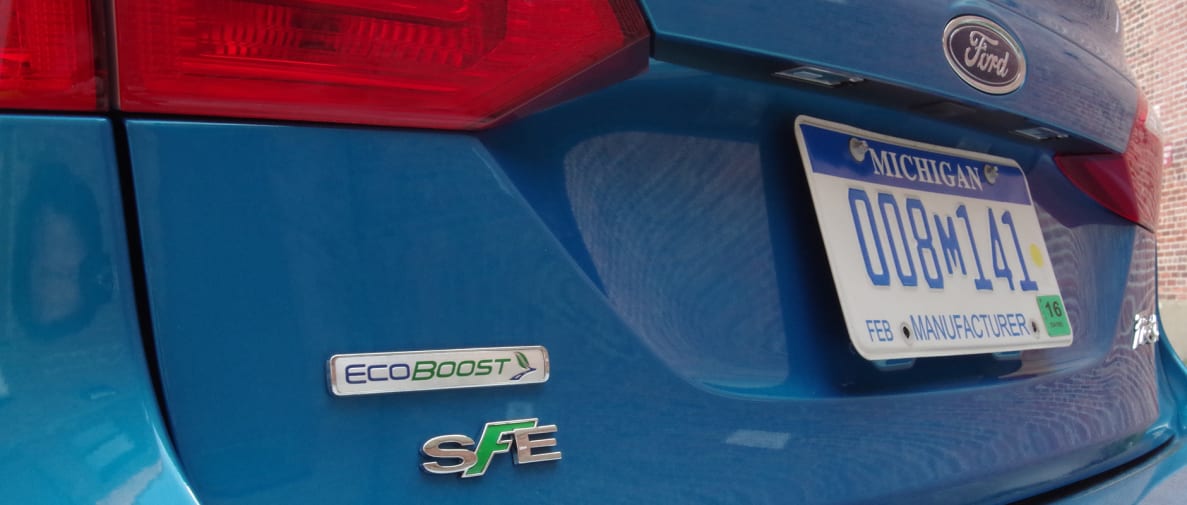Sure, then-Ford CEO Alan Mullaly famously kissed the engine when it first debuted, and Ford engineers have been on a media blitz explaining the merits of the new mill.
But take a look at the Fiesta SFE EcoBoost, and the only mention of a three-cylinder engine will be on the window sticker. Coincidentally, that sticker will also boast a fuel economy of 31 mpg city, 43 highway, and 36 combined—and an MSRP that's about $1,000 more than a comparable four-cylinder model.
{{ photo_gallery name="exterior" }}
The reluctance to market the new three-cylinder engine alongside the car that it powers signals that Ford is proud of its innovation, but nervous about how the public will receive it. After all, the last three-banger cars sold in the U.S.—the Geo Metro, Subaru Justy, and Daihatsu Charade—weren't exactly paragons of luxury.
It's a smart strategy, especially for a car this refined. In fact, if I hadn't done my homework, I would never have believed the Fiesta I drove for a week had a three-cylinder under the hood. The little 1.0-liter engine puts out an impressive 123 horsepower and 148 lb.-ft. of torque—more than the Fiesta's standard four-cylinder.
Sure, I might have questioned some of the odd noises coming from in front of the dashboard. The magic used to squeeze maximum power out of the tiny powerplant resulted in purring and whirring unlike any other engine I've heard.
In addition to turbocharging and direct injection, Ford added unique cooling and anti-vibration technologies. They keep the engine cool and quiet, but result in a low, distant thrum for an exhaust note.
Most importantly, however, the engine never struggled. Merging onto a highway in third gear, I matched traffic speeds before I had to upshift. A CVT-equipped hybrid would've given me a jarring drone, and even a non-turbo four would've felt winded. The three-cylinder Fiesta, on the other hand, was eager to please and up for the challenge.
Similarly, the butter-smooth 5-speed transmission proved a perfect partner. This is one forgiving stick shift, and it adds a lot of fun to the driving experience—even in stop-and-go traffic. If you've never driven a manual before, this is a great car to learn on.
The fact that buyers can't get an automatic shouldn't be a deal breaker—though I don't envy the salesperson who has to convince the average car buyer to pay more for a trim level that features three cylinders and a stick shift.
{{ photo_gallery name="INTERIOR" }}
And that's not the only compromise. The upgraded MyFord Touch interface that I appreciated on the Fiesta I drove earlier this year isn't available if you choose the SFE EcoBoost trim level. In fact, opting for the smaller engine pares down the whole option list.
Instead of a touchscreen and navigation, the car features two columns of similar-looking buttons, plus a tiny LED screen. Connectivity is courtesy Ford's Sync system, which is fine for Bluetooth audio, but lacking when it comes to voice recognition.
Sync Services will do in a pinch when it comes to searching for a destination or getting directions without a dedicated navigation system. It uses your phone's data plan to access MapQuest (yup, MapQuest) and then downloads the destination it finds to your vehicle.
Unlike Hyundai's basic BlueLink Guidance turn-by-turn system, for instance, Sync requires an initial registration for Sync Services turn-by-turn directions, which some users may find confusing. At $60 per year after the initial free trial period, it's also cheaper than OnStar and BlueLink. News, weather, and movie listings are available, too—but we think it's worth it to pull over and check your phone for those.
I get it: In-dash tech isn't where the Fiesta SFE EcoBoost is supposed to shine. But if Ford is trying to attract younger buyers looking for a small, sporty, fun-to-drive, efficient car, it will have to offer more —and that includes an automatic transmission and better in-car tech. Otherwise, people won't even bother with a test drive. That's a shame, because this Fiesta is most impressive when it's on the road.
Meet the tester
Keith was the Editor in Chief of Reviewed's appliance and automotive sites. His work has appeared in publications such as Wired, Car & Driver, and CityLab.
Checking our work.
Our team is here to help you buy the best stuff and love what you own. Our writers, editors, and experts obsess over the products we cover to make sure you're confident and satisfied. Have a different opinion about something we recommend? Email us and we'll compare notes.
Shoot us an email

